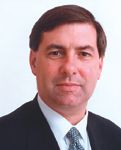Article
Ophthalmic committee develops guidelines for treating patients atrisk for ectasia
San Francisco-A team of ophthalmologists founded the EctasiaCommittee in the hopes of summarizing the current knowledgeregarding ectasia and refractive surgery and developingrecommendations to prevent the development of the condition,explained Eric D. Donnenfeld, MD, at the annual meeting of theAmerican Society of Cataract and Refractive Surgery (ASCRS).
San Francisco-A team of ophthalmologists founded the Ectasia Committee in the hopes of summarizing the current knowledge regarding ectasia and refractive surgery and developing recommendations to prevent the development of the condition, explained Eric D. Donnenfeld, MD, at the annual meeting of the American Society of Cataract and Refractive Surgery (ASCRS).

"The Ectasia Committee was formed for the benefit of ophthalmologists performing refractive surgery to attempt to reduce the occurrence of this disorder and to improve patient outcomes," Dr. Donnenfeld said. He is a founding partner of Ophthalmic Consultants of Long Island, Rockville Centre, NY, and Fairfield, CT, and associate professor of ophthalmology, New York University Medical Center, New York.
In addition to Dr. Donnenfeld, the members of the committee include: Perry S. Binder, MS, MD; Richard L. Lindstrom, MD; R. Doyle Stulting, MD, PhD; Steven G. Slade, MD; Helen Wu, MD; and Peter J. McDonnell, MD.
Need for topography
The committee first concluded that topography should be performed on all patients who were to undergo refractive surgery and that the computer-generated indices are not necessarily accurate. There are no absolute indicators for patients who go on to develop ectasia. In addition, the development of ectasia can mean that the procedure was contraindicated but can also mean that the procedure was not necessarily contraindicated, Dr. Donnenfeld recounted.
The committee also concluded that little is known about the risk factors for ectasia after surface ablation, so that risk factors that apply for LASIK may not apply for surface ablation. The members also concluded that ectasia is a known risk factor of laser vision correction, and the occurrence of ectasia after laser vision correction does not necessarily mean that the procedure was contraindicated or that the standard of care had been violated, Dr. Donnenfeld reported.
Other conclusions were that forme fruste keratoconus is a topographic diagnosis and is not a variant of keratoconus. Forme fruste keratoconus implies the presence of subclinical disease with the potential to progress to clinical keratoconus with or without surgery.
Topographic risk factors for ectasia include asymmetric inferior corneal steepening, and an asymmetric bowtie topographic pattern that is skewed above or below the horizontal meridian. Topographic risk factors also include an inferior crab claw pattern, also called pellucid marginal degeneration, according to Dr. Donnenfeld.
The committee recommended how to address patients with topographic abnormalities.
"We suggest that surface ablations be considered in patients with mild topographic findings or not do the procedure, but that in mild cases surface ablation can be considered as long as the patients provide informed consent after receiving documentation of the abnormal topography," he said.
In addition, Dr. Donnenfeld noted that the committee did not establish formal guidelines, but rather recommendations. Specifically, these recommendations are that surgeons review the topography before laser vision correction and that intraoperative pachymetry be performed in all cases in which the residual stromal bed may approach 250 μm.
"For the future, the committee has submitted a formal request to ASCRS to fund a formal prospective study to determine the prevalence of predisposing ectatic disorders," Dr. Donnenfeld said. "We are considering developing an online monograph to discuss the current technology for detecting these disorders. Most importantly, we are all concerned with this problem and we request all input from ophthalmologists to the committee."
References
1. Binder PS, Lindstrom RL, Stulting RD, Donnenfeld E, Wu H, McDonnell P, Rabinowitz Y. Keratoconus and corneal ectasia after LASIK. J Refract Surg 2005;21:749-752.
2. Binder PS, Lindstrom RL, Stulting RD, Donnenfeld E, Wu H, McDonnell P, Rabinowitz Y. Keratoconus and corneal ectasia after LASIK. J Cataract Refract Surg 2005;31:2035-2038.
Newsletter
Don’t miss out—get Ophthalmology Times updates on the latest clinical advancements and expert interviews, straight to your inbox.




